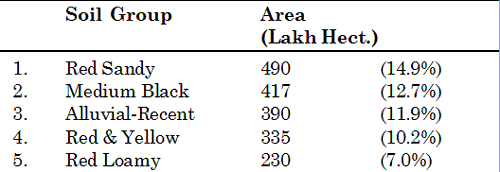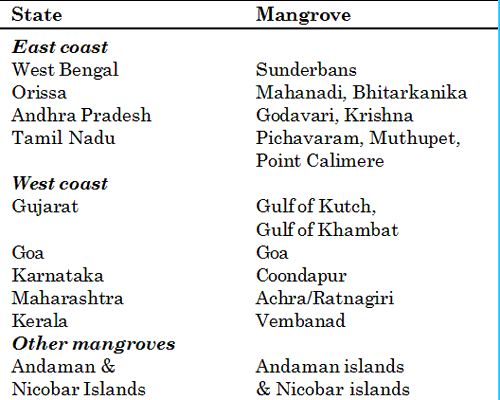(Sample Material) Online Coaching for CAPF (AC): Geography - "Indian Geography (Part - 3)"
Online Coaching for UPSC Central Armed Police Forces (AC) Written Examination
Geography
Indian Geography (Part - 3)
Soils
Broad Soil Groups by Area

Black Soils
- They are also known as ‘Regur’ and `Black cotton’ soils.
- They are spread over 5.46 lakh sq km (16.6%) of the total geographical area of the country.
- The black colour of these soils has been attributed to the presence of a small proportion of titaxiferous magnetite or even to iron and black constitutents of the parent rock.
- The black soil is very retentive of moisture. It swells greatly and become sticky when wet in rainy season.
- They are self-ploughing soils.
- They contain lime, iron, magnesium, alumina and potash but lack phosphorous, nitrogen, organic matter and humus.
- Generally, the black soils of uplands are of low fertility but they are darker, deeper and richer in the valleys.
Red and Yellow Soils
- Most of the red soils have come into existence due to weathering of ancient crystalline and metamorphic rocks.
- The soil develops a reddish colour due to a wide diffusion of iron in crystalline and metamorphic rocks. It looks yellow when it occurs in a hydrated form.
- It covers about 3.5 lakh sq km (10.6%) of the total geographical area of the country.
- The red soils are poor in lime, magnesia, phosphatic nitrogen and humus, but are fairly rich in potash.
- Their pH value ranges from 6.6 to 8.0.
- They are lying on the periphery of the peninsular plateau.
- They are not retentive of moisture.
Laterite Soils
- The laterite soils are formed in the areas of high temperature and high rainfall with alternate wet and dry periods.
- These are the result of intense leaching. With rain, lime and silica are leached away and soils in iron oxide and aluminium compound are left behind.
- They are poor in organic matter, nitrogen, phosphate and calcium.
- They cover an area of 2 48 lakh sq km.
- The laterite soils on the higher areas are generally more acidic than those in the low-lying areas.
- They are widely cut as bricks for use in house construction.
Arid and Semi-arid Soils
- They cover an area of 1,42 lakh sq km (4.32%) of the total area of India.
- The desert soils consist of Aeolian sand (90 to 95%) and clay (5 to 10%).
- They are generally sandy in structure and saline in nature.
- Nitrogen is insufficient and the phosphate content is normal.
- Lower horizons of the soil are occupied by ‘Kankar’ layers because of the increasing calcium content downwards.
- These soils are poor and contain little humus and organic matter.
Saline and Alkaline Soils
- They are known by different names such as reh, kallar, usar, thur etc.
- Saline soils contain a larger proportion of sodium, potassium and magnesium and thus, they are infertile.
- They occur in arid and semi-arid regions and in waterlogged and swampy areas.
- They lack nitrogen and calcium.
Peaty and Marshy Soils
- They are found in the areas of heavy rainfall and high humidity.
- They are rich in humus and organic content.
- Organic matter may go even up to 40-50%.
- They are normally heavy and black in colour.
Forest and Mountain Soils
- These soils occupy about 2.85 lakh sq km (8.67%) of the total land area of the country.
- Such soils are mainly found on the hills slopes covered by forests.
- These soils are heterogenous in nature and their character changes with parent rocks, ground-configuration and climate.
- The forest soils are very rich in humus but are deficient in potash, phosphorus and lime.
- The forest soils are loamy and silty on valley sides and coarse-grained in the upper slopes.
Natural Vegetation
Vegegation Type
- India’s vegetation can be divided into 5 main types and 15 sub-types:
Moist Tropical Forests
- Tropical Wet Evergreen
- Tropical Semi-evergreen
- Tropical Moist Deciduous
- Littoral and Swamp
Dry Tropical Forests
- Tropical Dry Evergreen
- Tropical Dry Deciduous
- Tropical Thorn
Monstane Sub-tropical Forests
- Sub-tropical Broad Leaved Hill
- Subtropical Moist Hill
- Sub-tropical Dry Evergreen
Montane Temperate Forests
- Montane Wet Temperate
- Himalayan Moist Temperate
- Himalayan Dry Temperate
Alpine Forests
- Sub-Alpine
- Moist Alpine Scrub
- Dry Alpine Scrub
Tropical Wet Evergreen Forests
- It is found in the areas where:
- The annual rainfall exceeds 250 cm;
- The annual temperature is about 25°-27°C;
- The average annual humidity exceeds 77%; and
- The dry season is distinctly short.
- Areas - The western side of the Western Ghats, a strip running from north-east to south-west direction across Arunachal Pradesh, Upper Assam, Nagaland, Andaman & Nicobar Islands etc.
- Species of trees -White cedar, Mesua, Jamun, Nopea etc.
Tropical Semi-evergreen Forests
- These are found in the region where:
- The annual rainfall is 200-250 cm;
- The mean annual temperature varies from 24° to 27°C; and
- The relative humidity is about 75%.
- Areas - Western coast, Assam, lower slopes of the Eastern Himalayas, Orissa and Andamans.
- Species of trees - Aini, Semul, Kadam, Rosewood, Kusum etc.
Tropical Moist Deciduous Forests
- These are found in the areas with
- Moderate rainfall of 100 to 200 cm per annum;
- Mean annual temperature of about 27°C: and
- The average relative humidity of 60 to 70%.
- Areas - along the Western Ghats surrounding the belt of evergreen forests, a strip along the Shiwalik range including terai and bhabar from 77° E to 88°E, hills of eastern Madhya Pradesh, Chhattisgarh, Chhotanagpur and part of Orissa and West Bengal.
- Species of trees - Teak, Sal, Laurel, White Chuglam, Badam, Mahua etc.
Littoral and Swamp Forests
- These forests occur in and around the deltas, estuaries and creeks.
- These forests can survive and grow both in fresh as well as brackish water.
- These forests account for 7% of the world’s total mangrove area.
- Species of trees - Sundari, Agar, Bhendi, Amur etc.
Tropical Dry Evergreen Forests
- Along the coasts of Tamil Nadu, these forests occur in short stature.
- Annual rainfall is about 100 cm;
- The mean annual temperature is about 28°C;
- The mean humidity is about 75%.
- Species of trees - Khirni, Jamun, Tamarind, Neem etc.
Tropical Dry Deciduous Forests
- These are similar to moist deciduous forests and shed their leaves in dry season.
- These forests can grow in areas of even less rainfall of 100-150 cm per anuum.
- Species of trees - Teak, Axlewood, Tendu, Pal as, Bel etc.
Tropical Thorn Forests
- These forests generally occur in the area of low rainfall (less than 50 cm) and high temperature (25°-30°C).
- Areas - north-western parts of the country including Rajasthan, south-western Punjab, western Haryana, Kuchchh etc.
- Species of trees - Khair, Neem, Babul, Cacti, Palas etc.
- Acacias are very prominent in the region and Euphorbias and Indian wild dates are also common.
Sub-tropical Broad- leaved Hill Forests
- There forests occur in the eastern Himalayas to the east of 88°E longitude at altitudes varying from 1000 to 2000m where the mean annual rainfall is 75 cm to 125 cm, average annual temperature is 18°-21° C.
- They form luxurious forests of evergreen species.
- Species of trees - Oaks, Chestnuts, Sals and Pines (on lower and higher margin respectively) etc.
- They also occur in the Nilgiri and Palni Hills at 1070-1525 m above sea- level.
Sub-tropical Moist Pine Forests
- They are found at the height of 1000 to 2000 m above sea level in the Western Himalayas between 73° E and 88°E longitudes.
- Chir is the most dominant tree.
Sub-tropical Dry Evergreen Forests
- These are found in the Bhabar, the Shiwaliks and the western Himalayas upto about 1000 m above sea-level.
- Here, rainfall is between 50 to 100 cm.
- Olive, Acacia, Modesta and Pistacia are the important species of trees.
Montane Wet Temperate Forests
- The forests grow at a height of 1800 to 3000 metres above sea level in areas where the mean annual rainfall is 150 cm to 300 cm, the mean annual temperature is about 11 °C to 14°C and the average relative humidity is over 80%.
- They are found in the higher hills of Tamil Nadu and Kerala, in the Eastern Himalayan region to the east of 88° E longitude.
- Species of trees: Deodar, Chilauni, Indian Chestnut, Birch, Blue pine etc.
Himalayan Moist Temperate Forests
- These forests occur in the temperate zone of the Himalayas between 1500 and 3300 metres where rainfall varies from 150 cm to 250 cm.
- Such forests are mainly composed of coniferous species.
- Pines, Cedars, Silver firs, spruce, etc are most important trees.
Himalayan Dry Temperate Forests
- These are coniferous forests with xerophytic shrubs.
- Such forests are found in the inner dry ranges of the Himalayas.
- Deodar, Chilgoza, Oak, Olive, etc are the main trees.
Sub-alpine
- They occur at the upper limit of tree forest adjoining alpine scrub and grasslands.
Moist Alpine Scrub
- They occur at the height of 3000 m and extend upto snowline.
- They are a low evergreen dense growth of Rhododendron, Birch, Berberis etc.
Dry Alpine Scrub
- It is the uppermost limit of scrub xerophytic, dwarf shrubs, over 3500 m above sea level and found in dry zone.
- Juniper, Honeysuckle, Potentilla etc are important species.
Mangroves
- Mangroves are very specialized forest ecosystem of tropical and subtropical region of the world bordering sheltered sea-coasts.
- They occur all along the Indian coastline in the sheltered estuaries, tidal creeks, backwaters, salt marshes and mudflats, covering a total area of 0.67 m ha.
- Mangroves are dominated by salttolerant halophytic plants of diverse structure, and are invaluable marine nurseries for a large variety of fish and other marine fauna.
- They support a large variety of birds, amphibians and many other local arboreal, benthic and water creatures.
- Mangroves have a dense network of aerial roots which help to aerate the root system and anchor the tree.
- Suadari is widespread in Sundarbans, screw pines, canes and palms are common in deltas. Cracks are often lined with Nipa.
Mangroves of India

- The uses of mangroves are many. It provides fuel wood and hard durable timbers used for construction and boat making. It stops soil erosion, stabilize the shoreline and act as bulwark against encroachment by the sea. Mangroves are an efficient nutrient trap. They act as pollution filters.
- The mangroves of India have been subject to immense biotic pressures and ruth-less exploitation owing to overexploitation and increasing disposal of sewage and industrial waste.
Distribution of Forest Area
- Forest & tree cover of the country as per State Forest Report 2009, is 78.37 million ha in 2007, which is 23.84% of the geographical area. This includes 21.02% forest cover and 2.82% tree cover.
- India’s total forest is nearly 2% of the total forest in the world.
- Minimum desired area for a tropical country like India is about 33%. Further it should be about 60%
